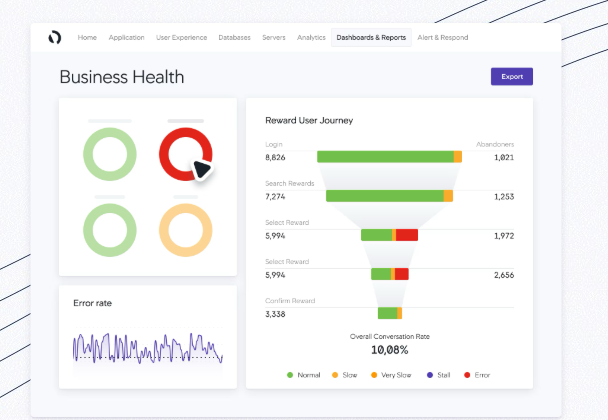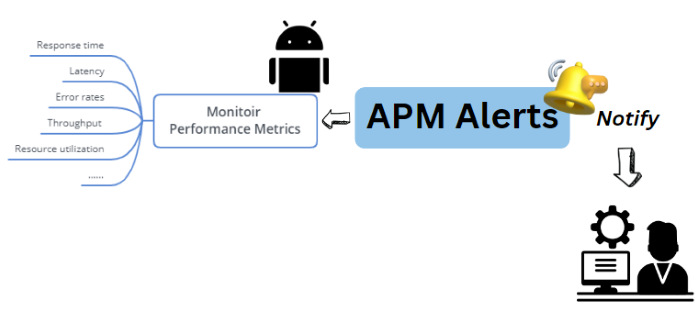- It generates an app usage report.
- It provides app usage history.
- It can monitor the current status of the apps.
- This tool can manage multiple devices remotely.
- It provides data usage reports.
Application Performance Monitoring(APM) & Alerts for Android
Imagine you are an IT admin and you realize the enterprise network is slow. You troubleshoot the network issues only later to find out that there is a problematic application slowing down your network speed.
While you have identified and maybe fixed the problem, it probably took you longer and maybe disrupted or slowed down some critical operations in your enterprise. This is exactly what happens when you don’t have a mechanism to monitor app performances in your network infrastructure. This is where Application Performance comes in handy!
Well, this article takes you through everything you need to know about Android Application Performance (APM) alerts for Android including the best practices and tools you can leverage to effectively monitor app performances for your enterprise:
Part 1. What is App Performance?
App performance can be defined in various ways often depending on the interest of the user. One way is to describe it based on how well an application runs on a device. For example, you could consider factors like how long it takes to open, how often it crashes, accuracy, stability, and more.
These are the issues that app providers or app developers will be concerned about. Again, app performance can also be defined by looking at metrics related to data usage, network speed, battery consumption, and security.
It is crystal clear that app performance is a comprehensive term yet important in defining the effectiveness of enterprise processes. Therefore, it is crucial for enterprises to monitor all the app's performance on their company-owned devices.
This is particularly important to MSPs since they need to satisfy their customers with better services. It is only by monitoring the performance of these apps that they can effectively identify and address issues triggered by app flaws.
Part 2. Why Should IT Operation Monitor App Performance?
We are now in a world where apps are pretty much a part and parcel of enterprise operations these days. It’s thus no-brainer that you ought to ensure that your apps are running and utilizing resources effectively. Here are some of the top reasons for monitoring app performance in IT operations:
1Reduce the downtime of Apps
App performance monitoring helps MSPs easily identify app issues on their client’s apps. Since they can monitor and easily identify the issue, it saves troubleshooting time and consequently, reduces the MTTR.
For example, if you are helping a customer manage their Vending Machines, you need to make sure the machines work normally. If the app is down and customers cannot use the machine, then, with the app performance monitoring, you can easily know what's the problem and solve it.
2Resource Optimization
With app performance monitoring, it is easy to monitor resources on the target device. For example, you can check the storage and CPU usage in real-time and decide whether you need to allocate more resources for better app performance.
3Ensure Network Stability
App monitoring gives IT operators insights into the performances and potential issues within the apps. Some app issues can disrupt other operations and network performances causing network instability. With monitoring, you can easily identify the issues and rectify them to ensure the affected network regains stability.
4Enhance Security
App performance monitoring provides an avenue to identify potential risks and vulnerabilities in the application environment. As an IT admin, you can find and you can address these vulnerabilities, say by deploying relevant security patches or restrictions to end devices for enhanced device and data security.
Part 3. Best Tools for App Performance Monitoring
One of the best ways to effectively monitor app performance across multiple devices with different requirements is to use a tailored app performance monitoring tool. In fact, there are several good app performance monitoring tools worth giving a try in the market.
Here are our top three picks.
1Datalog
Best for enterprises that need comprehensive monitoring for app performance
Datalog is a popular AI-powered app performance monitoring tool that traces performance issues from browsers to back-end servers. It is widely known because of its ability to provide comprehensive monitoring for app performance including network, log, user experiences, security signals, and other telemetry.
This makes it easier to detect and address the genesis of app performance issues. Datalog is suitable for enterprises that need deep monitoring for applications on their managed devices.
You can learn more about it from the video:
Key Features
- It provides visibility into resource consumption and execution time for methods, code lines, and threads.
- It can track and send alerts regarding business-specific KPIs.
- It can analyze the impact of incidents in both upstream and downstream services.
- It provides an error-tracking capability that helps group errors into manageable issues.
2AirDroid Business
Best for enterprises that need to monitor app usages and need reports and alerts for better app monitoring
Android Business is one of the most powerful app performance monitoring apps in the market. This tool allows enterprises to seamlessly manage a fleet of devices remotely by managing the application usage and performance. This tool can provide a report of data usage, monitor the status of the app, and receive alerts if the app is down.
This allows users to swiftly identify and resolve app performance issues to enable minimum downtime. AirDroid Business tool can also give you a detailed history of app usage and remotely check the app installation reports for individual apps.
3AppDynamics
Best for app developers monitor the user experience, crash time of the app, and more.
AppDynamics is another good app monitoring tool that lets you observe and secure your applications across different environments for optimized performance. It lets you build SAP resiliency by monitoring and maintaining peak performances from end-user to back-end.
This tool is suited for app developers because it is tailored to monitor the performance of an app. With this tool, you can monitor the user experience, crash time of the app, and more to help you optimize it.

Key Features
- It allows users to monitor peak performance.
- It provides a Smart Agent feature for centralized and automated agent management.
- It can monitor the current status of the apps.
- It allows the correlation of logs with application metrics and events to help accelerate troubleshooting.
Part 4. APM Alert for Enhancing Application Monitoring
As you’ve seen, there is so much riding on application performance in enterprise settings. However, APM alone may not be enough and you might need APM alerts to streamline your app performance monitoring.
While APM gives you a platform to monitor the performance metrics of apps across devices in a network, for example, APM alerts give you app performance notifications to help you identify and address issues in time. Whether it is error, security, performance, transaction, or custom alerts, APM alerts come in quite handy in enhancing application monitoring and response.

Case Study of APM Alerts
A leading bank faced Frequent Crashes.
One of the well-known banks experienced frequent crashes with its online banking mobile app. The app was rated low on the Google Play store, with the reasons of sluggish performance. The IT team could not resolve issues instantly, and downtime was high, so the customers were not satisfied.
The IT team used the crash reporting tool to identify the reasons for frequent app crashes. After careful analysis, app crashes were reduced to 30%. They also optimize the application coding to save memory space and enable the app to run on devices without lowering the speed. APM provides them with a proactive approach to monitoring the real-time performance of applications by setting alerts for server outages. It helps them to reduce the downtime and improve customer experience.
Social media apps with High battery consumption
A few months earlier, one of the social media apps was discussed on various online platforms, with negative feedback. People started uninstalling it from their Android devices. When the app developers review users' feedback, they realize that the app is consuming excessive battery power, and its performance is also affected. However, developers need to learn app performance to build trust with users.
Food Delivery App with tracking issues
A well-known fast food point with around 500 daily deliveries was afflicted with order management processes from the mobile app. This mismanagement resulted in everyday financial and reputational loss because customers were not entertained like the routine procedure.
Summary
APM and APM alerts for Android are transforming how enterprises and MSPs identify, monitor, and address app performance issues on their client devices. APM offers a myriad of benefits and is worth investing especially if you are an enterprise or MSP handling multiple devices with many applications powering your operations. While there are several APM software, you can always go for the tools that meets your needs on your budget.






Leave a Reply.